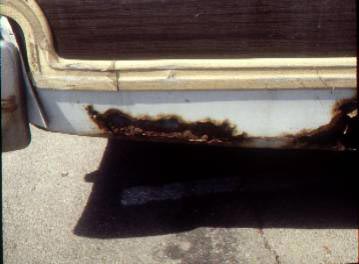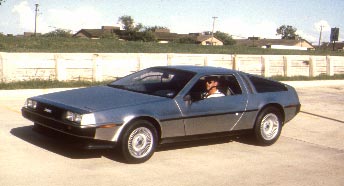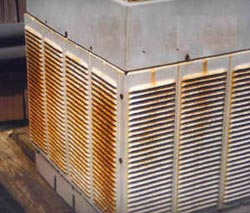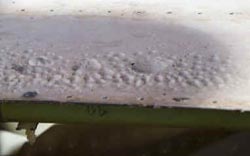
Corrosion Control
There are a number of means of controlling corrosion. The choice of a means of corrosion control depends on economics, safety requirements, and a number of technical considerations.
| Design Protective Coatings Corrosion Allowances | Materials Selection Inhibitors Cathodic Protection |
Design

Engineering design is a complicated process that includes design for purpose, manufacturability, inspection, and maintenance. One of the considerations often overlooked in designing manufactured products is drainage. The corrosion of the automobile side panel above could have been minimized by providing drainage to allow any water and debris to fall off of the car instead of collecting and causing corrosion from the far side of the panel.
All of the other methods of corrosion control should be considered in the design process.
Materials Selection
Carbon Steel
Most large metal structures are made from carbon steel-the world’s most useful structural material. Carbon steel is inexpensive, readily available in a variety of forms, and can be machined, welded, and formed into many shapes.
This large statue by Pablo Picasso in front of the Chicago city hall is made from a special form of carbon steel known as weathering steel. Weathering steel does not need painting in many boldly exposed environments. Unfortunately, weathering steel has been misused in many circumstances where it could not drain and form a protective rust film. This has given the alloy a mixed reputation in the construction industry.

Where other means of corrosion control are not practical, other alloys can be substituted for carbon steel. This normally doubles or more the material cost for a structure, and other corrosion control methods must be considered before deciding on the use of more expensive alternates to carbon steel.
Some forms of carbon steel are subject to special types of corrosion such as hydrogen embrittlement, etc.
It is common practice to limit the allowable strength levels of carbon steel to avoid brittle behavior in environments where environmental cracking may occur. High strength bolts cannot be galvanized for the same reason-a concern that they may hydrogen embrittle due to corrosion on the surface.
Stainless Steels
The stainless steel body on this sports car is one example of how stainless steels can be used. The stainless steel is virtually immune to corrosion in this application-at least in comparison to the corrosion that would be experienced by conventional carbon steel or aluminum auto bodies.

Aluminum
Aluminum alloys are widely used in aerospace applications where their favorable strength-to-weight ratios make them the structural metal of choice. They can have excellent atmospheric corrosion capabilities. Unfortunately, the protective properties of the aluminum oxide films that form on these alloys can break down locally and allow extensive corrosion. This is discussed further in the section on intergranular corrosion.

The highway guardrail shown on the right is located near the ocean in Florida. The aluminum alloy maintains a silvery shine except in locations where the passive film has suffered mechanical damage. The wear caused by the rail touching the wooden post at this location destroyed the passive film on the edges of the rail and allowed intergranular corrosion to proceed and cause the exfoliation corrosion shown above. While the corrosion above is very interesting and makes for an interesting web site, it is important to note that the railing is decades old and would have never lasted as long in this location if it were made of carbon steel.
Intergranular corrosion is a major problem on airplanes and other structures made from aluminum alloys. It frequently occurs at bolt and rivet holes or at cutouts where the small grain boundaries perpendicular to the metal surface are exposed.
Copper Alloys
Brasses and bronzes are commonly used piping materials, and they are also used for valves and fittings. They are subject to stress corrosion cracking in the presence of ammonia compounds. They also suffer from dealloying and can cause galvanic corrosion when coupled with steel and other structural metals. Most copper alloys are relatively soft and subject to erosion corrosion.
The dezincification shown above could have been controlled by using inhibited brasses which have been commercially available since the 1930’s.

Titanium

Titanium is one of the more common metals in nature, but its limited use means that small-scale production operations result in a relatively expensive metal. In the United States it finds extensive use in the aerospace industry. The Japanese make extensive use of titanium in the chemical process industries.
There are two general types of titanium alloys-aerospace alloys and corrosion resistant alloys. The crevice corrosion of an aerospace alloy flange in a saltwater application is a classic example of how titanium gets misused.
Protective Coatings
Protective coatings can be metallic, such as the galvanized steel shown below, or they can be applied as a liquid “paint.” Most of the research and testing of protective coatings at the Kennedy Space Center is related to paint-like protective coatings.

Filiform corrosion occurs underneath protective coatings. The air conditioner on the left is starting to show rust stains due to problems with protective coating. The same types of problems are starting to appear on the aluminum airplane wing shown on the right.


Inhibitors
Corrosion inhibitors are chemicals that are added to controlled environments to reduce the corrosivity of these environments. Examples of corrosion inhibitors include the chemicals added to automobile antifreezes to make them less corrosive.
Corrosion Allowances
Engineering designers must consider how much metal is necessary to withstand the anticipated load for a given application. Since they can make mistakes, the use of the structure can change, or the structure can be misused, they usually are required to over design the structure by a safety factor that can vary from 20% to over 300%. Once the necessary mechanical load safety factor has been considered, it becomes necessary to consider whether or not a corrosion allowance is necessary to keep the structure safe if it does corrode. The picture shows extra steel added to the bottom of an offshore oil production platform. The one inch of extra steel was added as a corrosion allowance.

Cathodic Protection
Cathodic protection is an electrical means of corrosion control. Cathodic protection can be applied using sacrificial (galvanic) anodes or by means of more complicated impressed current systems. This Louisiana fishing boat has sacrificial zinc anodes welded to the hull to slow down corrosion. No pattern is apparent to how the anodes were attached-the design philosophy seems to be that if one anode is good, more is better.
